Imaginative and Alternative Dance Ecologies
An Interview with Petra Kuppers
BY EMMALY WIEDERHOLT
Petra Kuppers is a dancer, writer, community performance artist, and disability culture activist based in Ypsilanti, MI. She is the artistic director of The Olimpias, an international disability culture collective, and co-creator alongside her wife Stephanie Heit of Turtle Disco, a somatic writing studio. Here, Petra describes how she uses imagination to activate and engage community in accessible ways, like through her virtual Starship Somatics classes, or to track and celebrate hidden disability dance lineages, like in her Crip/Mad Archive Dances at the New York Public Library’s Dance Division.
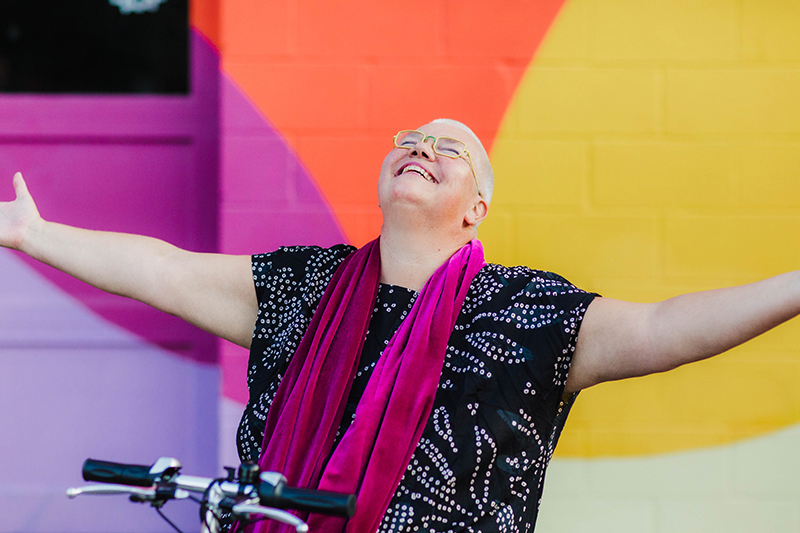
Visual description: Petra Kuppers, a white queer disabled cis woman of size with yellow glasses, shaved head, pink lipstick and a black dotted top, smiles up to the sky, arms outstretched, embracing the world. Her mobility scooter’s handlebar is visible at the bottom of the image. She is in front of a multicolored wall: purple, pink, yellow and orange. Photo by Tamara Wade.
~~
How did you get into dance and what has shaped you as a dance artist?
I’m German, born in a small village in rural Germany, a first generation high school finisher in my immediate family. I knew early on that I loved dancing. I was introduced to Laban work in school. Before that, I hated PE; I was in a lot of pain, and it was hard for people to understand why I was in pain at that time – my official diagnoses (and my mobility devices, canes and a wheelchair) only arrived in my late teens. But once choreography became part of my school’s PE curriculum, my path in life was set.
I wanted to become a choreographer and to apply to dance schools in Germany. However, I couldn’t because I needed a certificate from a doctor that I had four sound limbs. So from the get-go, I couldn’t develop this interest in a conventional way, so I went the unconventional way. At the University of Cologne I visited the dance studios, presented my ideas, and asked if I could create a show. They said yes. I translated my own version of Frankenstein, and conceived of it as a dance performance. I was deeply influenced by Tanztheater and the work of Pina Bausch. Frankenstein had diverse people dancing in it, some students, some squatters in houses in Cologne, some workers – my first experience of community performance, now my core modality. We had this intense process for a year of deep somatic exercises that shaped us into the emerging bodies of Frankenstein. And that was my first ever show.
How was your first choreographic work received?
The student theater people completely supported me. In Germany at the time, we had a stronger respect than in the US for a director/choreographer’s weird vision. The public reviews were a bit more mixed. One reviewer felt that they were in a class for people preparing for giving birth, and that it was a weird ritual. Every show I’ve made ever since, someone could have written more or less the same thing. That reviewer probably hadn’t meant their write-up to be positive, but I actually really love that first glimpse of how my work was received.
You are the artistic director of The Olimpias, an international disability culture collective. How did The Olimpias come together and how would you describe its work to someone unfamiliar with it?
The Olimpias started about 25 years ago in Wales. As a disabled person in Germany, opportunities were hard to come by. Now there are people making disability dance in Germany, but for me at the time, I didn’t feel like there were a lot of openings. When I was 24 years old I moved to Britain and became part of the disability culture there. I worked as a community dance artist in rural Wales for 10 years, mainly with mental health system survivors, with people in the last months of their lives in hospices, and with people in significant pain. I developed a form called Dance with a Difference, very similar to what I’m doing now, as a way of inviting more people into improvisational delight.
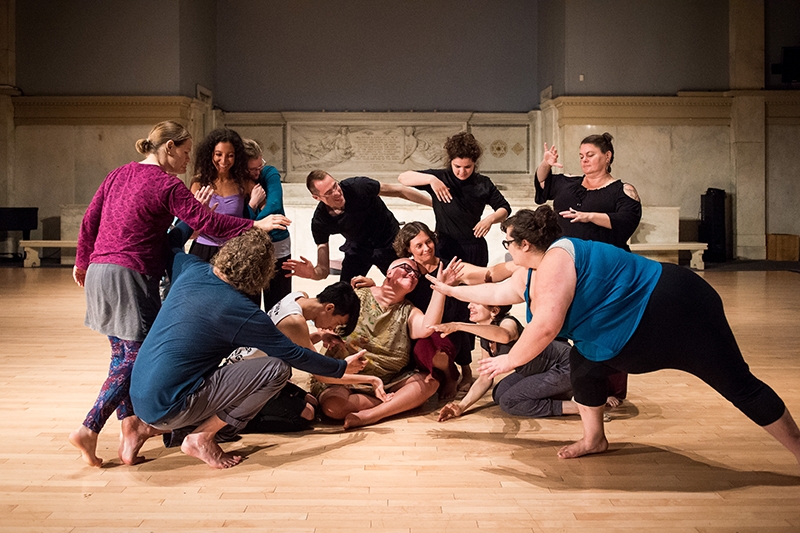
Visual description: A group of people of different genders, racial backgrounds, and body shapes in an Asylum Project dance at Judson Church, on a wooden floor, with marble walls in the background. All reach and roil, a swirl of movement patterns and arm and eye connections. Photo by Ian Douglas.
I started The Olimpias with a particular show in the late 90s, when I was working in a small town in Wales with people severely impacted by their experience of living with mental health conditions. Some of us had medication put into our bodies against our wills, some had experiences with homelessness or incarceration, some had severe side effects of medications. We’d been working together for years as part of a mental health self-help group, but people felt uneasy about appearing on a stage, about performing a conventional show for their families and the mental health gatekeepers – many had tremors from medication side effects, or memory impairments. So I asked, “What else can we do to show our beauty?” As part of our rehearsal work, we’d been engaging in dream journeys where we danced internally and went on inner journeys to the deep ocean, swaying with fish and plants, warming us up for outer movement. So we decided to take this serenity of the dream journey as a starting place. We created a video installation in Swansea in a shopping mall where people could come into a dark room with comfy cushions and watch people who are labeled mad – and the popular image of madness is of course of raving psychos, tics, and unpredictability. Audiences could see us lying there breathing and hear our dream journey. You had a choice: you could either participate in the journey, relax, and be with us, or you could look at us and try to see the psycho in us. That was how The Olimpias was born: on the cusp of movement and media engagement, and in the tension between seductive participation and cultural anxieties around stigmatized disability.
The Olimpias is now a loose association of artists, many disabled and some not, some with mental health differences and some not, people with different experiences of exclusion. Many do not do stage work, and that is a significant difference between my work and many other companies that center disabled dancers. We are often people who, because of pain, mental health difference, poverty, the life situations we’re in, cannot commit to regular rehearsals or appear on stages: we find other ways to share presence and energy.
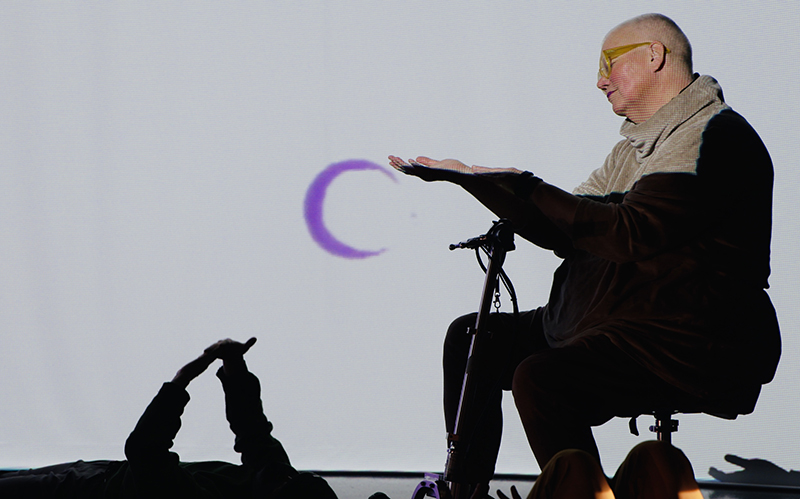
Visual description: Petra, a white queer disabled cis woman of size sits on her scooter, and reaches out her hand to a Starship Somatics video projection of a purple moon. Below, a floor dancer reaches up and touches their own hands. Photo: video still, Petra Kuppers, Photographer: videostill/The Olimpias
The group is also quite international because of the places I was fortunate to call home. Beyond Germany and the UK, I have lived in Aotearoa/New Zealand, Australia, and now the US, with many participants in Canada, too. Wherever I am, I meet fellow disabled people, and whenever we come back together, we pick right back up again. The Olimpias are pockets of people who value one another and love to move together, usually outdoors, more often on the edge of car parks rather than on official stages – an alternative dance ecology.
I understand you currently run weekly online disability culture movement classes called Starship Somatics through the organization Movement Research. Can you share more about how those classes came about and what they entail?
Before the pandemic, I had created Turtle Disco with my wife, dancer and poet Stephanie Heit, in our home. When the pandemic happened, we were missing our community, and our dancing and co-presence. So I developed a creative somatic modality that would be disability culture friendly and could work online. Starship Somatics started in March 2020, and it’s been going on ever since. I worked on it first through Turtle Disco, and then Movement Research approached me to run online classes through them. I now offer it every week, and it’s a completely improvised journey. Here is the official description: “Starship Somatics engage our bodymindspirits as portals, as trance-mobiles that honor pasts and jet us toward speculative futures, among the stars or deep into the earth, in flux and transformation.” Here is an example of one of these sessions, created as an underwater video dance with Charli Brissey:
This last Tuesday morning, my Zoom screen came alive with 15 people, from Finland, Britain, Colombia, Scotland, and all over the USA. We went on a dream journey, connecting ourselves to the Indigenous land we were on, and traveled a few inches into the soil. We all were in the northern hemisphere, so we had a spring journey where we were traveling with unravelling, emerging plants. We unfurled alongside the plants. Then one of these plants offered us a nest in a leaf. The leaf encapsulated us, until we were in a leaf skeleton spaceship travelling through outer space. We met on a disco platform in space, and we danced to “Space is the Place” by Sun Ra, a foundational hymn for this work. We traveled to another planet, asked permission, and were welcomed into the cells of alien plants, nourishing ourselves and giving energy back.
In these sessions, everybody develops their own idea of what movement patterns are part of these experiences, and what is accessible to them. When I look at the screen, some people are lying down, engaged in an inner or microscopic dance journey. And on about half the screens, people move around their living rooms, in external dances with imaginary and real plants. In Starship Somatics, all these modalities are welcome, inner and outer movement, and access is centered. We’ll start these dances up again in September 2023, weekly through Movement Research.
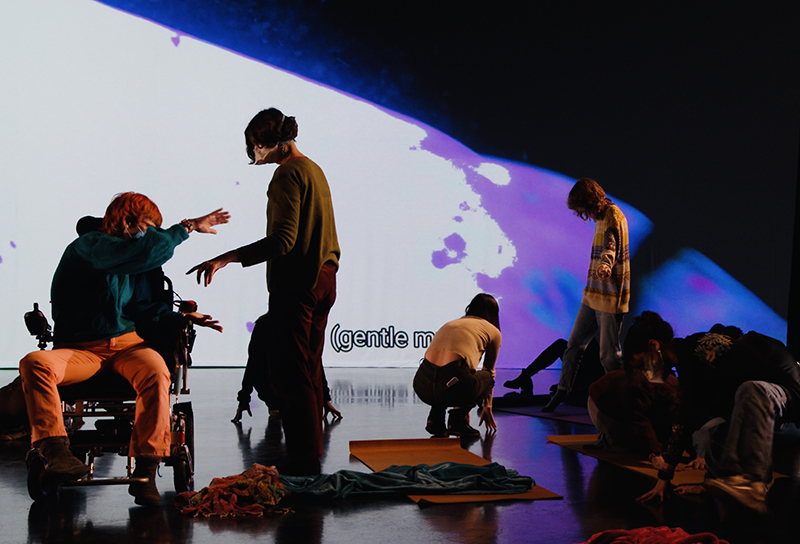
Visual description: A group of people dancing against the background of the Starship Somatics video projection in vibrant violet and white. Gwynneth VanLaven, a white disabled person with red hair and orange trousers, is using a powerchair and is reaching out to a masked person, their hands just about to touch. Others are exploring space and ground, in between yoga mats. Photographer: videostill/The Olimpias
As you mentioned, you are the co-creator alongside your wife Stephanie Heit of Turtle Disco, a somatic writing studio. How would you define somatic writing, and what does Turtle Disco’s programming look like?
Prior to Turtle Disco, I didn’t own a house or car for a decade – I was a gigging artist. I was either teaching at the University of Michigan or making my way around the world teaching and performing. I also spent a lot of my time in the Bay Area where I lived for nearly seven years with my previous partner, the late disability culture artist Neil Marcus. When I got together with my wife, Stephanie Heit, who is a disabled poet and dancer, we decided we wanted to create a base. I was interested in sustainability and ecological issues, and I wanted to calm down my traveling for my own bodymindspirit and in respect for this land. We found a home in Ypsilanti, MI, on Anishinaabe Territory. What sold us on the house were two things: it had a hot tub inside, great for pain management, and it also had a front room with a beautiful wooden floor and windows that look out to the street. That room became Turtle Disco. We invited local people, mainly queer and disabled, to come move with us. For a few years, people could bike, walk, or take a short drive and join us in our sessions. Then the pandemic hit. Since then, we have not gone back to in-person sessions because so many of our community are immune-compromised. The online sessions we’re offering include Starship Somatics and Amoeba Dances, which is a mixture of Continuum Movement-inspired work and poetic creative modalities. Stephanie runs Contemplative Movement and Writing Practice based on Barbara Dilley’s lineage. Outdoors, we also have a fun series, “Turtle Disco Goes…Jurassic,” etc, where we visit a site – a crane sanctuary, a lake, dinosaur skeletons, or an automotive museum – and engage in site specific movement explorations. We are now in our sixth year, and we offer about two sessions online per week.
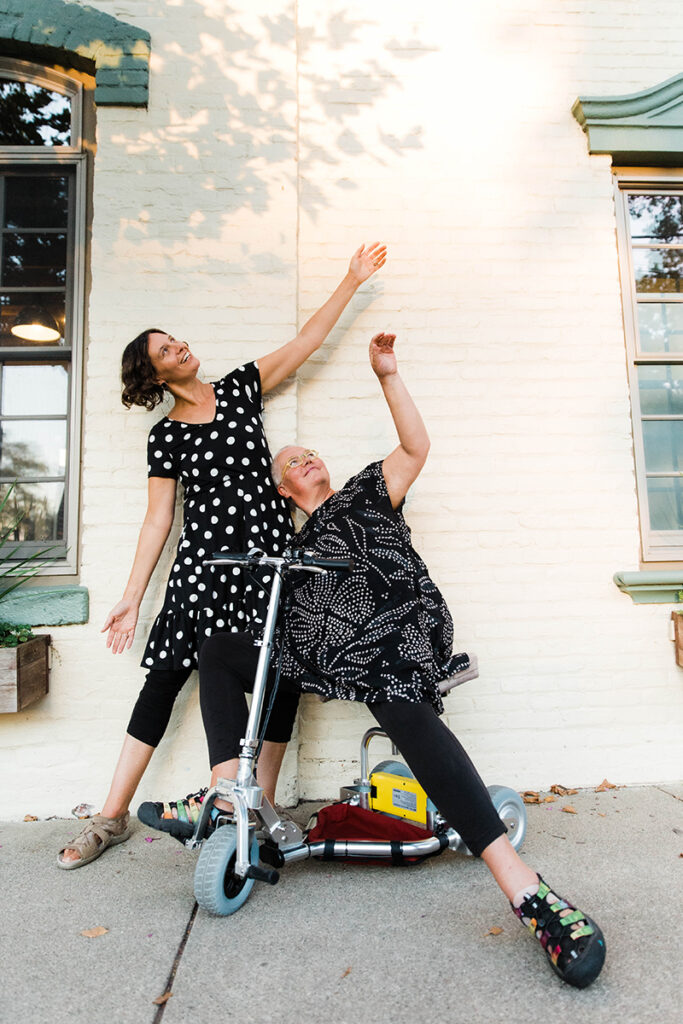
Visual description: Two white queer cis women: Petra, with yellow glasses, shaved head, pink lipstick and a black dotted top seated on a mobility scooter, and Stephanie Heit, standing with brown bob in a black-and-white polka dotted dress. Both lean back against a cream-colored house wall, and reach upward with their left arms, smiling, in contact and community play. Photo by Tamara Wade.
In addition to Turtle Disco, you are a published author who writes poetry, speculative fiction, and academic books. How does your writing practice inform your dance practice, and vice versa?
It informs it quite intensely. The shorthand I usually give is “when I can’t dance, I write,” but the two forms are more deeply connected than that. Just like my speculative imagination is important in how I move in the world, writing is for me an unfolding of sensation. I witness movement in my academic work: the delicious discomforts and stumbles of improvisational openings I call eco soma practice. I write from a disability culture perspective, as someone who is attuned to a painful embodiment, in deep attention to being in the world. I also write poetry and speculative fiction, and all these are informed by my particular rolling or stumbling way of being in the world, by the intensity in which I experience touch or can track small movements because sometimes I am indeed quite immobile with pain. I might be quite still but I track the movements that are available to me and the movements of the environment I’m in – temperature, wind, a fellow being’s touch, the touch of different pasts, and of dreaming, emerging futures. I engage that tracking through writing, dancing, and drawing. All these modalities are rich to me.
In 2021, you were a Dance Research Fellow at the New York Public Library’s Dance Division, where you created the ongoing Crip/Mad Archive Dances. What are the Crip/Mad Archive Dances?
This incredibly generous offer from the Jerome Robbins Dance Division allowed me to use divinatory methods to track disability dance ancestors in the archive. How do we hold on to people who have not been officially called into our lineage? There have always been disabled people and mad people – how can we track and honor those people? We cannot find them easily using the traditional methods of a historical archive, as terms like “disability” and “madness” are stigmatized and often erased or euphemized. How can we track them through longing or listening? How can I listen past, for instance, the families who don’t wish to have their family members actually named as having HIV/AIDS? How many people would have wanted to be called into the archive? How can we undo stigma imaginatively? That’s the impetus of this project.
In 2021, during my residency, I found dancers in the historical archive during the day, and every night I called upon dancers with disabilities in NYC to come together and join me in Lincoln Square, outside the archive. We explored the gestures and movement material I had found in the archive together. We re-embodied ancestral gestures among ourselves.
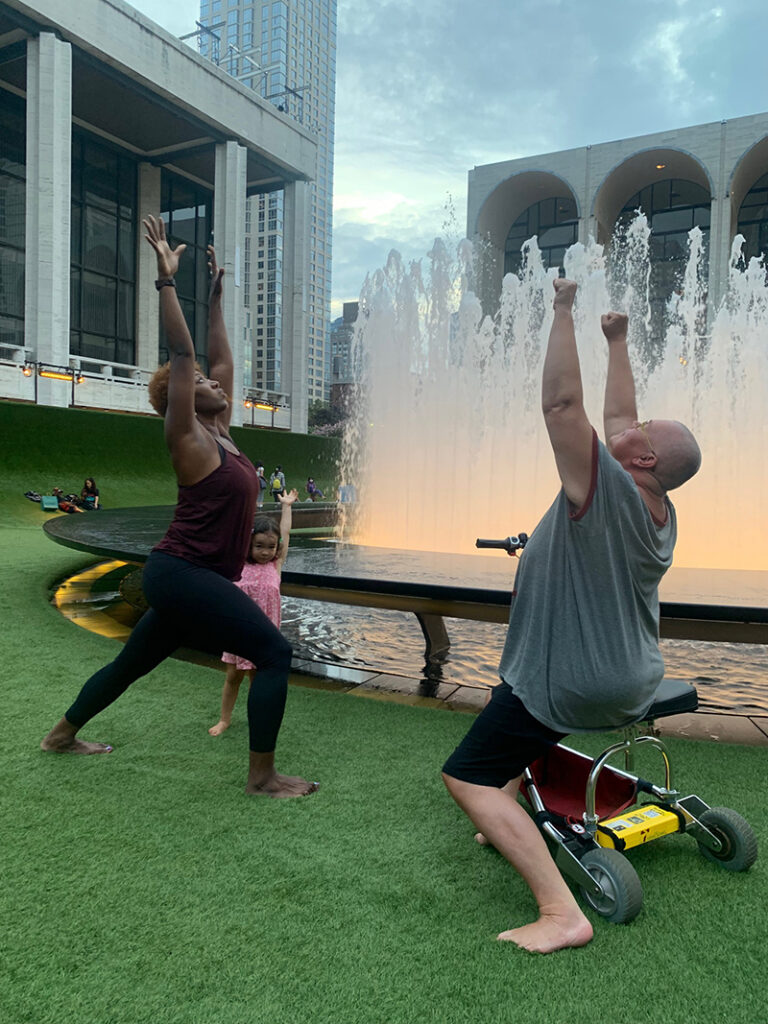
Visual description: Crip/Mad Archive Dances: Hettie Barnhill, a queer Black woman, and Petra, a queer white woman of size, stretch, raising their arms toward the sky, holding a memory from Raimund Hoghe’s repertoire, one of the elders honored in the Crip/Mad Archive Dances. Hettie is standing in a lunge, Petra is seated on a mobility scooter. A fountain shoots jets of water into the air. A small child, a community passer-by, extends hands to the sky in the same stretch, partially hidden behind Hettie’s body. Photo by Kate Freer.
This past May 2023, I went back to the Jerome Robbins Dance Division, and we did the opposite. We brought many contemporary disability and mad dance gestures, gifted by my collaborators, into the archives and shared them inside the stacks. We connected to the trees that the books were made from, the materiality of the archive. We also used chance procedures to find a word in a book and created a new story for ourselves around that word, connecting ourselves to the text. These are the kinds of methods I love using. It’s a surreal and fantastical journey that allows us to connect to mad and disabled dance lineages.
I recently got a Guggenheim Fellowship to continue working on this. I’m in the process of creating a longer video, 30+minutes, with many community media contributions, which I have begun to tour – a performative lecture full of movement invitations from a diverse and rich set of mad and disabled artists.
What’s next for you? Do you have an upcoming project or focus you’d like to share more about?
I will be further developing the video/live performances of the Crip/Mad Archive Dances, as well as a book about the project. The Guggenheim Fellowship I received is for a mixed project of critical and creative methods. It’s so important to me that the Guggenheim Fellowship recognized these mixed methods of critical and creative work, honoring new trajectories of knowledge creation: a great place for disability culture development.
I will run an online Crip/Mad Archive Dances workshop through Movement Research’s MELT program at the end of July 2023. I invite people to join us to find ways of honoring their own bio and chosen lineages through fantasy and dance improvisation.
~~
To learn more, visit www.petrakuppers.com.
